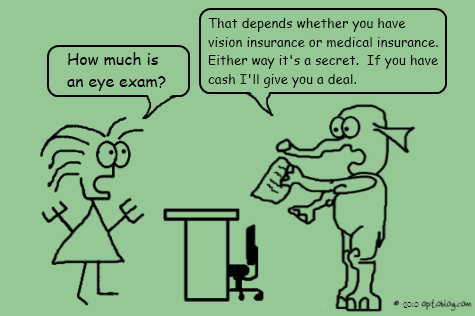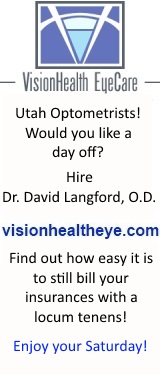OBA 2012 Practice Metrics are out for Walmart-Sam’s Club Optometrists
Each year the Optometric Business Academy releases their survey results for practice stats of Walmart and Sam’s Club affiliated doctors. (The OBA should not be confused with the MBA, Management and Business Academy run by the same sponsors for private practice optometrists.)
The OBA has the 2012 metrics for download here, and you’ll probably have to log in to get it. Even though it is the 2012 report, it’s really analyzing 2011 stats.
If you were to guess the most likely day an optometrist takes off, you would guess Sunday, of course. But did you know the second? Turns out that about a quarter of us take Mondays off. That’s me, too. I like to pretend I have a weekend.
And seriously, here are some points they make that I ordered and would like to discuss:
- Typical affiliated ODs spend less than
0.5 percent of gross fee income for
marketing. The median expenditure is
$500 annually, a sum insufficient to fund
any significant initiative.- Affiliated ODs are generally less
active in service improvement processes
recommended by service experts than are
private practice ODs.- Among the major advantages of hiring
staff is the ability to shape a service
culture and service standards to deliver a
consistently excellent patient experience.- …only a minority of affiliated practices actively market medical eye care services today.
Okay, #1. Part of the reason that I don’t spend on advertising is that I don’t collect a lot of money to do so AND I’m in a high traffic location anyway, so spending a lot on external marketing doesn’t make a lot of sense. Maybe Sam’s Club doctors should spend more, but one of the advantages of being a Walmart doctor is that my marketing budget can be low since I have more awareness by default. Also, private practice doctors spend more on marketing because they sell $500 pairs of glasses. I only collect money on exams. My gross is much less, so my overhead should be less and that includes the marketing dollars.
#2 and #3 are related. Again it goes back to overhead. If I wanted the headaches of hiring, paying, training, providing benefits, scheduling, managing complaints, and firing staff…then I would be a private practice doctor. If I let Walmart handle the headaches, then why can’t I also let Walmart handle the service improvement process while I make the occasional suggestion? Also, where am I supposed to get all this money to compensate the staff I hire? If I’m a one-room doctor whose appointment book is not full, then what incentive do I have to spend money on staff? If I’m a doctor whose appointment book is starting to get full, it’s a big cut in pay for me to hire more staff, hope business picks up, and somehow try to change exam-traffic flow in a Walmart optical floor plan.
Speaking of which, where does my hired air-puffer do my insurance billing when they’re not taking acuities? There is no nurse’s station. The Walmart floor plan needs to change before I get crazy and hire a staff of people.
#4. I’ve been hearing for years about how we’re supposed to be on board with the “Medical Model” which is a code word for billing a lot more medical insurances, which is more code for jacking up your medical fees because “you don’t want to leave any money on the table.”
First, there are three major insurance carriers in my area who only allow ophthalmologists on their panels- no optometrists. Second, if I start seeing a whole bunch of medical insurance people, then my accounts receivable will go up, and these are sicker patients who take up more time in the chair. Then I’ll have to start raising exam fees. Once I start raising exam fees, business will taper off because that’s the whole reason most people come to Walmart: the exam is cheaper.
Some people think it’s fine to charge a wildly different exam fee for “medical” vs “routine vision,” but I’ve addressed this topic elsewhere. In summary, I don’t think having a $50 “routine” eye exam while charging $150 for a “medical” eye exam is ethical.
On the other hand, I would love to charge some patients more if their case is complicated, but try explaining that to someone who got quoted a certain price, so that’s why they signed up for an exam. They won’t be happy paying more than they expected.
I wouldn’t mind having an hourly rate. I think that would be more fair for everyone except the insurance companies.
Tags: Consultants, Income, management, MBA, metrics, OBA













